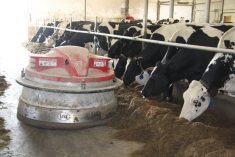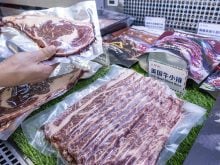DES MOINES, Iowa – Kenichi Masuda runs a 1,000 sow farrow-to-finish operation in central Japan.
That makes his operation large by Japanese standards and makes it difficult for his company to see and test new products and practices.
“That is why we come over,” said Hiroshi Takahashi, a Japanese hog company executive and translator for Masuda.
“The most advanced technology for swine production is at this World Pork Expo.”
Takahashi and Masuda were keenly intent on understanding how an automatic sorting system works and how it could fit into their operation in Japan. Few Japanese hog farms use automatic sorting – which can provide uniform loads of slaughter hogs – because most Japanese hog farms are small.
Read Also

Manitoba extends Crown land rent freeze
Manitoba government links the continued rental rate freeze on grazing and forage leases to economic and environmental challenges facing the industry
However, a big producer like Masuda Farm could gain a marketing edge from technology like this because “that is what our packers are looking for.”
The World Pork Expo is the crossroads of the world pork industry. Hundreds of visitors from across the hog production world attend each year, with large contingents from countries such as Mexico, the Philippines and Canada scouting new technologies and checking out their U.S. competitors.
For some, like Takahashi and Masuda, it’s a place to learn about new technology that can replace old practices.
For others it’s a place to promote old and forgotten parts of the pig world, ones that could still have a modern application.
“I was surprised by how many people there were that wanted to talk about traditional breeds and talk about the logistics of moving them over here,” said Sue Merrill, a member of the British Pig Association delegation and a promoter of the Large Black pig.
She and colleague Tracy Bretherton, who promotes the Middle White breed, were trying to entice American and other pig producers to consider incorporating almost-forgotten heritage breeds from the United Kingdom in their breeding programs.
The Large Black pig, in particular, interested some U.S. farmers because it does not fall victim to sunstroke as easily as pink and white pigs, Merrill said. For U.S. producers who rear animals outdoors, it may be a better breed than run-of-the-mill commercial breeds.
Bretherton said her Middle Whites contain unique genetics because they were created by breeding York pigs with the Small White, which is now extinct.
Breeder John Millard of the British Pig Association said he’s been coming to the World Pork Expo since 1994, during which time he has watched North American pig genetics advance rapidly, partly due to genetics from pigs in Great Britain.
“They’ve nearly caught up,” he said.
He sniffed with disdain when asked how small British breeders could compete with the giant breeders that supply genetics from hog heavyweights Denmark and the Netherlands.
“We’re better than the Danes and the Dutch,” he said.















